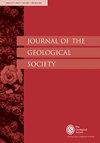东安纳托利亚断层Pazarcık段地表破裂历史和18 ka长的滑动速率
IF 3
3区 地球科学
Q2 GEOSCIENCES, MULTIDISCIPLINARY
引用次数: 1
摘要
我们研究了东安纳托利亚断层Pazarcık段的古地震和滑动速率,该段涉及2023年2月6日Pazarcık-Kahramanmaraş地震(Mw:7.7)的地表破裂,并提供了这一主要大陆断层的长期行为的见解。来自两个海沟遗址的古地震数据,揭示了全新世时期至少五个地表破裂的证据。公元1114年的历史地震在两个海沟地点都得到了证实,但公元1513年的地震只在一个地点得到了证实。此外,较老事件的年龄差异表明,历史活动被500年至1000年的较长相对静止期隔开,这表明Pazarcık段的子段发生了准周期性地震。断层平行沟在近18 ka和近9 ka分别在隐蔽河道和实际河道上显示了101±5 m的偏移。通道的最大和废弃年龄与测量的偏移量的相关性揭示了断层的长期滑动率为5.6 mm a -1。补充资料:https://doi.org/10.6084/m9.figshare.c.6850786本文章由计算机程序翻译,如有差异,请以英文原文为准。
Surface rupture history and 18-ka-long slip rate along the Pazarcık segment of the East Anatolian Fault
We investigate the paleo earthquakes and slip-rate on the Pazarcık segment of East Anatolian Fault which has involved surface rupture of 6 February 2023 Pazarcık-Kahramanmaraş earthquake (Mw:7.7) and provided insights of the long-term behavior of this major continental fault. Paleoseismologic data from two trench sites, reveal evidence for at least five surface ruptures in the Holocene Period. The historical earthquake of 1114AD is verified at both trench sites but the following event of 1513AD is only identified at one site. In addition, the age difference of the older events shows historical activity are separated by much longer periods of relative quiescence that range from 500 years to 1000 years which suggest quasiperiodic earthquake occurrence on sub-segments of the Pazarcık segment. Our fault parallel trenches revealed 101±5 m offset in the last 18 ka and 51±1 m offset in the last 9 ka on a buried stream channel and the actual channel of the same stream respectively. The correlation of the maximum and abandonment age of the channel with measured offsets revealed 5.6 mm a -1 long-term slip rate of the fault. Supplementary material: https://doi.org/10.6084/m9.figshare.c.6850786
求助全文
通过发布文献求助,成功后即可免费获取论文全文。
去求助
来源期刊

Journal of the Geological Society
地学-地球科学综合
CiteScore
6.00
自引率
3.70%
发文量
68
审稿时长
6-12 weeks
期刊介绍:
Journal of the Geological Society (JGS) is owned and published by the Geological Society of London.
JGS publishes topical, high-quality recent research across the full range of Earth Sciences. Papers are interdisciplinary in nature and emphasize the development of an understanding of fundamental geological processes. Broad interest articles that refer to regional studies, but which extend beyond their geographical context are also welcomed.
Each year JGS presents the ‘JGS Early Career Award'' for papers published in the journal, which rewards the writing of well-written, exciting papers from early career geologists.
The journal publishes research and invited review articles, discussion papers and thematic sets.
 求助内容:
求助内容: 应助结果提醒方式:
应助结果提醒方式:


